Robert W. Endlich
PREFACE
What determines a nation’s success or failure on the battlefield?
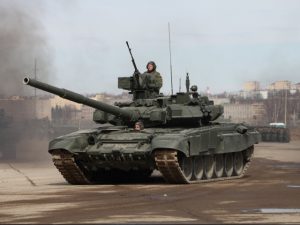
The answer to that question has been debated throughout history and is ongoing as I write this, as Russian troops engage Ukrainian fighters in Ukraine. Many factors are involved in the answer to this question, including quality and quantity of equipment and troops, control of the air, training and discipline of troops, and logistic support of those engaged in combat.
Another factor often determines the outcome: Weather and Weather’s effects on the terrain and the skies above.
I spent twenty-one years in the Air Force as a Weather Officer, three of which were as Staff Weather Officer to the Army’s VII Corps in Stuttgart,Germany during the Cold War, 1979-1982. In that assignment, I learned how my Army Corps was prepared to defend our sector of Germany, which extended from north of Wurzburg to Nuremberg, with our troops and M-60 tanks. We were defending against not only Soviet troop formations, but also against an entire Soviet TANK ARMY, the Eighth Guards Tank Army, whose number of tanks dwarfed ours.
To defend, we planned to use maneuver, moving our men and machines to points in the terrain where we could achieve tactical surprise and outgun our enemy.
Weather controlled how much our Air Force could provide Air Support, but weather also controlled the conditions on the ground. If tanks wandered into impassible, muddy conditions, and we could attack prior to them being retrieved, they were sitting ducks. If tanks could be confined to a road, such as a road through a forest, killing the first and last tank would leave a line of tanks which could not escape; we could kill them with dispatch.
I learned soil type, soil slope, and soil moisture determined how many tracked or wheeled vehicles could pass until the soil turned into an impassible mire.
I was assigned to work with the “G2 section,” Military Intelligence warriors who were responsible for knowing the Enemy, the Terrain, and the Weather. I did the Weather portion for them.
Lessons I learned with VII Corps helped me prepare this post.
SOME BACKGROUND ON UKRAINE’S CLIMATE AND TERRAIN
Ukraine has long been known as “Breadbasket to the World,” because of its rich soil, Prairie Black Earth, the Chernozym soils. With these soils, Ukrainian farmers are able to obtain good yields of wheat, corn, sunflower seed oil and more.
Prairie Black Earth contains a high amount of humus, organic material, allowing it to retain high amounts of water which enables the high agricultural output.
Maximum snow cover in Kiev is in December near the Winter Solstice. Coldest temperature occurs around 2 Feb, but beginning in mid-February, average maximum temperatures start to go above freezing, averaging 40F by mid-March. Maximum soil moisture occurs in February. So just as in many other places in Europe, and farming regions in the US, the return of longer days and higher sun in late February brings an end to frozen ground and begins “mud season,” which in Ukraine continues for some six to eight weeks.
The New York Times reports that Chairman Xi of the PRC, in a meeting with Putin just before the Beijing Olympics, asked Putin to delay invasion of Ukraine until after the end of the Beijing Olympics on 22 Feb 2022. Putin’s acceding to this request may have been an all-important event. The start day for the invasion may have been delayed, allowing the higher daytime sun and longer days to warm frozen soil, turning it into mud, and spoiling opportunities for tank maneuver over frozen ground. In any event, at 0500L on 24 Feb 2022 Russian formations started advancing into Ukraine.
PRE-INVASION CONCERNS
In the months and weeks prior to Russia’s invasion, the news was flooded with stories of how the Russians had massed tens of thousands of troops in southwestern-most Russia, next to Ukraine, and in southern Belarus. The number of Russian troops thus deployed were estimated by the BBC at 190,000 shortly before the invasion.
Gen Jack Keane, Director of the Institute for the Study of War, mentioned warming temperatures and the possibility of terrain going from frozen ground to mud saying, “Weather is clearly a factor” in his Fox News appearances. Keane, a retired four-star US Army general, said the spring mud in the region has long played a role in Russian warfare, having saved Russia from foreign invasions in the past. Keane said unpaved roads turn into ravines of mud when snow and ice begin to melt typically mid-to-late March. The muck can mire tanks and make moving military equipment a challenge, even in the 21st Century.
Media Elites had another view:
In the Washington Post, there’s a quote from the Center for Naval Analyses Russia Studies Program, viz., Ukraine’s terrain was
“considered ‘impassible except during winter.’”
They concluded,
“Russian troops have long proved quite adept at handling marsh and swamp terrain.”
In Foreign Policy Magazine, from the story, “A Little Mud Won’t Stop Putin—Frozen ground may aid a Russian invasion of Ukraine, but it’s not a decisive factor,” there is this gem,
“There are multiple factors, the ground is one of them, but it’s not in itself determinative. Russia is well-versed in operating in this area.”
In early Feb 2022, Fox news reported that
“Chairman of the Joint Chiefs of Staff Gen. Mark Milley told lawmakers that Kyiv could fall within 72 hours if a full-scale Russian invasion of Ukraine takes place,”
according to multiple congressional sources.
PLANNING FOR GROUND MANEUVER OPERATIONS
Armies exist to control the ground as an instrument of national policy. In the early development of armored vehicles powered by internal combustion engines, the ability to operate off-road became an important consideration, and during WWI the first tanks having tracks vs. wheels were developed.
Today, many variants of tanks and other armored vehicles use tracks to enable maneuvering cross-country to engender tactical surprise combined with firepower on the move without the necessity of using prepared road surfaces. Self-propelled howitzers also equipped with tracks allow the firepower of a cannon to be likewise moved cross-country, unencumbered by the necessity to use roads, to allow the set up and establishment of firing positions to rain down indirect (where the gunners do not directly observe the target) artillery fires against targets up to sixteen miles away, eighteen miles, if using rocket assisted propulsion (RAP) rounds.
There is an important flip side to this picture. The ability for tracked vehicles to maneuver cross country depends on the ability of the terrain and soil to support tracked vehicles. This situation brings in the necessity for knowledge of the terrain, soil type, soil slope, and water content of that soil. If the soil contains organic materials and clay, it is likely that once melted, it can become a mud trap for wheeled and even tracked vehicles. In successful “preparation of the battlefield,” this also requires knowledge of climatology and meteorology, including rainfall, surface temperature, and wind, factors which enable knowledge of the rate at which wet soils might dry out.
PICTURES, VIDEOS TELL THE STORY
Images from sources within Ukraine have shown me that many of the experts were wrong, especially about supposed prowess and progress of the Russian Army in Ukraine. Multiple images showed that tracked and wheeled Russian vehicles were confined to roadways, and vehicles that ventured off those roadways became mired in mud, sitting ducks for Ukrainian defenders.
These images show me that the Russians immediately encountered so much mud that any attempts at cross-country maneuver in an attempt to rapidly seize Kiev, were beset with terrain that could not be traversed. Both wheeled and tracked vehicles were forced to use only prepared roads, many, paved roads.
Here is a story told by the image and the description by NBC News in Figure 1 below. A Russian tank departed from a prepared roadway into a muddy bog just off the road and became mired in mud, unable to move. An apparent attempt to retrieve the tank with a steel cable and hooks failed, and the stationary tank was destroyed by Ukrainian defenders.
From the story,
“Russia’s attempts at a fast-paced assault haven’t brought its forces inside Kyiv, the capital and the seat of the Western-leaning government the Kremlin appears intent on removing. Instead, the strategy has stretched supply lines and morale to a breaking point, while Russian tanks and military equipment have, at times, gotten stuck in mud or run out of gas.”
Below, Smoke rises from a Russian tank destroyed by the Ukrainian forces on the side of a road in Lugansk region last week.
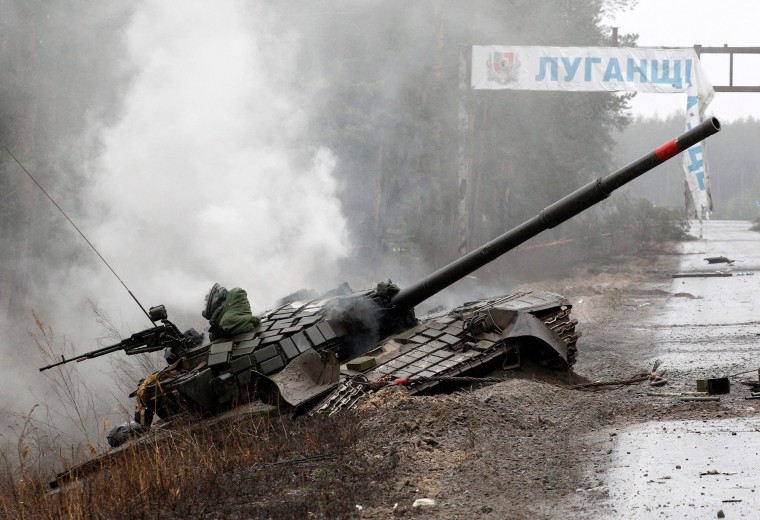
THREE IMAGES SHOW RUSSIAN TANKS BEING ATTACKED AND DEFEATED IN A FARM VILLAGE
Another series of images, screen captured from this UK Sun video shows the effects of Russian tanks attempting to attack Kiev from the north-northeast using pavement of the E95 highway, entering the farming village of Skybyn, on the northeastern outskirts of Kiev.
Figure 2 below shows a line of Russian main battle tanks approaching Skybyn; there is standing water in the farm fields alongside the north side of the E95 attesting to the saturated condition of the soil, and the reason the tanks’ travel is confined to the paved road.
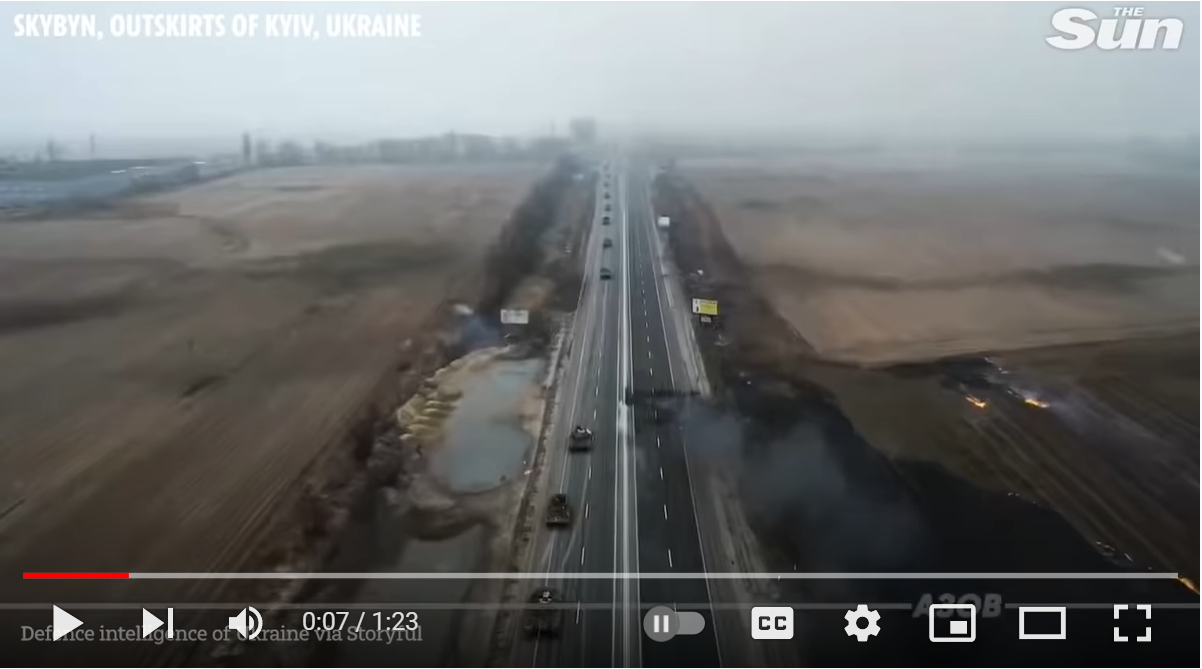
A few seconds later in the video, displayed as screen capture Figure 3 below, we see a pitched battle in Skybyn. Ukrainian defenders, concealed in the areas between houses in Skybyn have attacked the Russian tanks with anti-tank weapons. A bright explosion has enveloped one Russian tank, the blue smoke from other explosions of anti-tank weapons discharged in the midst of the tank formation is visible. Skid marks show where, amidst the attack, tanks have made sharp turns on the pavement of the E95 in efforts to escape the anti-tank weapons of the defending Ukrainians.
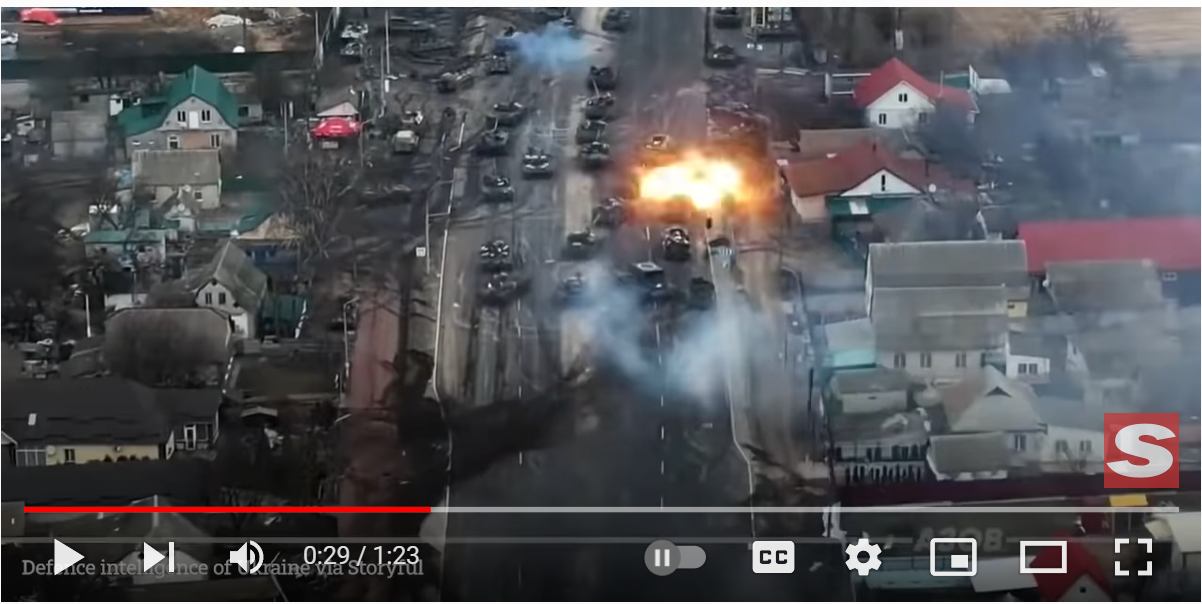
After a few moments, the video shows the tanks, now defeated. Many tanks are in the process of turning around while others are in full retreat from the northeastern edge of Skybyn. The presence of dense puffs of blue smoke shows that the tanks are still under attack by the anti-tank weapons used by the Ukrainian forces.

Beginning about 28 Feb 2022, Maxar Technologies reported a 40-mile-long convoy stalled on the road from the north into Kiev. Numerous news sources reported the story using Maxar’s satellite images. Figure 5 below is one such image which I have annotated with my interpretation.
The scene is on 28 Feb 2022, four days into the invasion, from an area near the Antonov Airport northwest of Kiev. I add these comments:
The fields are so sloppy that most vehicles are confined to the paved roadway or very close to the paved roadway. This points again to the ongoing mud season and the realization that wheeled or tracked vehicles were in danger of getting mired in mud if cross-country travel was attempted. This image indicates that any possible advantage of cross-country travel with tracked vehicles would be lost if cross country travel was attempted at this time. This brings inherent advantage to the defenders knowing attacking forces are confined to established roadways.
The brightest areas in the fields in this image appear to be standing water, another indication of saturated ground and extremely muddy conditions. Looking at the individual wheeled vehicle tracks into the open fields, it appears that the drivers soon realized that off-road conditions were very unfavorable and promptly looped back to the paved surface.
I interpret the wide spots in the vehicle tracks near the center of the image near the arrowheads are locations where the driver felt he was losing control, the vehicle slipping in the mud, and returned promptly to a hard surface.
Beyond the weather and trafficability features of this image are obvious indications of poor road march discipline. The vehicles need fuel, parts, and maintenance, yet the lanes are blocked with vehicles seemingly parked at all angles and in disorder.
Maintenance, supply, and the logistics of field operations were not instilled into this formation, pointing to the lack of an established Non-Commissioned Officer Corps in the Russian Army, lack of practice in convoy operations, units that had not trained in field operations, and diverse types of units, “combined forces” in US parlance, obviously had not trained together.
Which brings this question, far from weather and climate, but necessary to ask: Why were they not training and training together when the forces were being massed on the border of Ukraine?
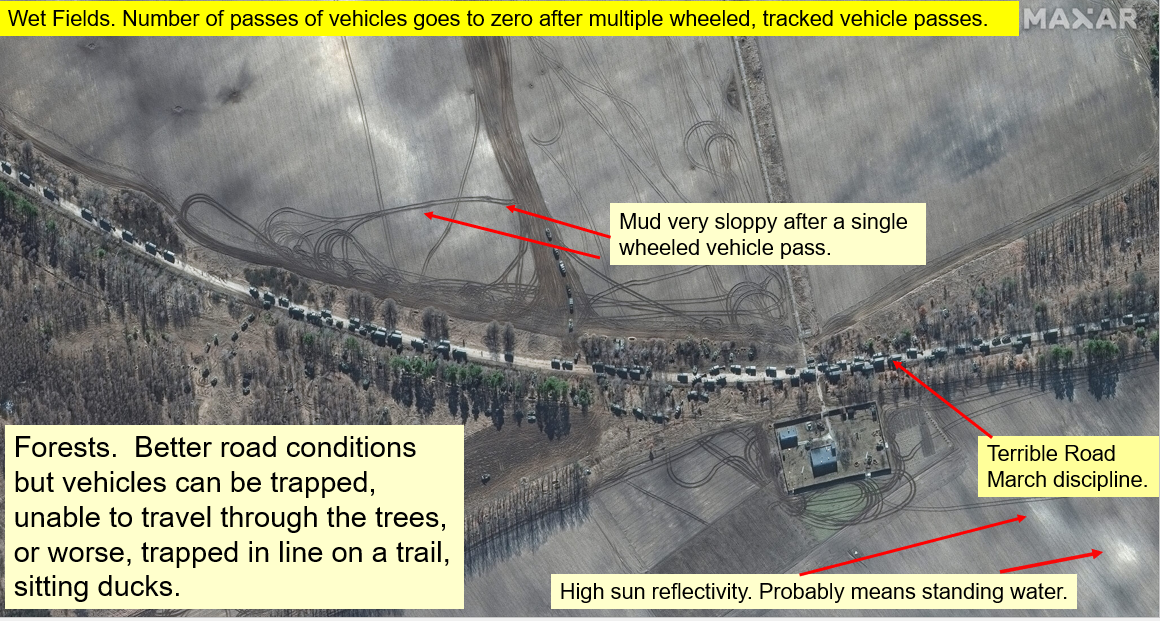
WHAT HAVE WE LEARNED?
Early expectations by media elites of Russian prowess were way off the mark. Early pronouncements that weather’s effects on the terrain would be no factor because of the expertise of the Russian invaders were wrong. Rather than frozen ground, invaders encountered extremely muddy ground. News images showed Russian tanks stuck in the mud, sitting duck targets, after venturing off established roads
Weather and weather effects had a dramatic impact on the war, confining attacking Russian vehicles to paved highways and roads, eliminating potential attacker advantages of cross-country maneuver using tracked vehicles. Satellite images showed convoys stopped, unable to be resupplied and unable to venture cross country. Weather and weather effects controlled the early days and weeks of the ground war.
The Ukrainians had tactical advantage in fighting the Russians, who were confined to established roads.
Failure by the Russian attackers in these early days to achieve surprise through cross-country maneuver, and the ability of the Ukrainian defenders to shape the defensive battle may have fatally blunted offensive blows by the Russians.
Early claims by many “experts” were wrong.
Only time will tell the outcome.
